-
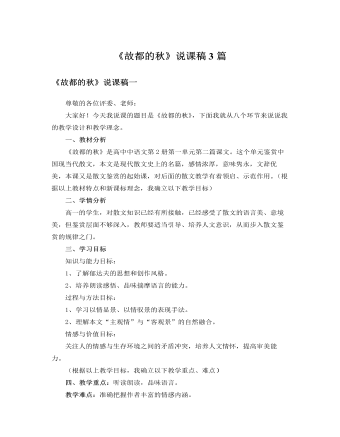
人教版高中语文必修2《故都的秋》说课稿3篇
请一位朗诵水平较好的学生,有感情的朗读课文12自然段,其他同学完成一项任务:这一段可否去掉?为什么?学生思考、圈画、交流、讨论,然后小组发言,其他小组补充,教师从旁予以点拨,引导学生进一步明确作者的思想情感。明确:作者要创造一种文化氛围,于自然气息之外再添一重文化气息,与“故都”题旨暗合。从行文章法上看,这里是宕开文笔,纵横议论,显出深厚的文化底蕴和开阔的思路。这一段采用议论,通过古今中外的引证,说明感秋处处有,中国文人最突出,而秋“深味”非在中国北方莫属,这其实还是为了突出故都之秋。(设计意图:提高学生探究的能力,充分把握本文的教学内容,深刻体悟作者的情感,了解作者对秋的礼赞情感,从而突破教学难点。)
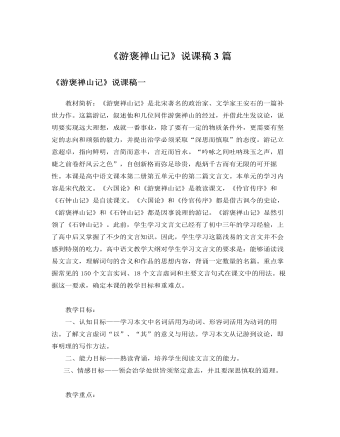
人教版高中语文必修2《游褒禅山记》说课稿3篇
学法指导:高一学生对文言文阅读已具备了一些基础知识和积累,但对如何学习文言文,还是一个新课题,因此教师应引导学生掌握学习方法,运用已有的知识框架同化新信息,建立新的智能,逐步走向独立学习的境界。一、引导学生利用课文注释,使用工具书自己翻译,必要时教师进行点拨、解难,培养自学能力。二、告诉学生翻译文言文要遵循的原则。三、调动学生思考、讨论、交流的积极性,教师适时点拨,培养学生发现问题、解决问题的能力。四、提示学生反复诵读课文,体会文章所阐述的道理。五、鼓励学生及时归纳学习文言文的方法,注意积累文言文知识。教学程序:教学本课可安排2课时。第一课时:1、导入新课:首先给学生介绍毛泽东的七绝诗《为李进同志题所摄庐山仙人洞照》:“暮色苍茫看劲松,乱云飞渡仍从容。天生一个仙人洞,无限风光在险峰。”学生通过诵读领会了“无限风光在险峰”一句的含义。随后因势利导,引出课题,指出今天我们要学习的王安石的《游褒禅山记》,就含有类似的深邃哲理。

人教版高中历史必修2开辟新航路说课稿3篇
一、说教材《开辟新航路》是高中《历史·必修二》第5课的内容。从三个方面向学生介绍了欧洲人开辟新航路的历史:即新航路开辟的原因和条件、新航路开辟经过以及影响。前4课内容介绍了古代中国经济的基本结构与特点,从第5课开始学习资本主义世界市场的形成和发展。本课内容相当重要,上承古代中国,下启近代世界。新航路的开辟,打破了世界相对隔绝的状态,世界真正开始融合为一个整体。从此,以西欧为中心的世界市场的雏形开始出现。随后的殖民扩张,世界市场拓展;第一次工业革命,世界市场基本形成;第二次工业革命,世界市场发展。二、说目标1、课程标准概述迪亚士、哥伦布开辟新航路的史实,认识地理大发现对世界市场形成的意义。2、三维目标①知识与能力:掌握新航路开辟的原因、经过、影响。②过程与方法:引导学生分析原因及影响,培养学生分析和归纳问题的能力。③情感态度与价值观:A、通过对新航路开辟过程的学习,使学生感受和学习探险家们勇于进取的开拓精神。B、通过学习新航路开辟的影响,使学生认识新航路开辟促进了人类社会的整体发展。

人教版高中英语必修2Computers说课稿3篇
一. 教材分析1. 本单元的中心话题是“计算机(Computers)”,内容涉及计算机的发展历史,计算机的应用等。本节课是该单元的第一课时,我将Warming up, Pre-reading and Comprehending这四部分整合为一节精读课。其中。Reading部分是题为WHO AM I?的文章,以第一人称的拟人手法介绍了计算机发长演变的历史和计算机在各个领域的应用,其主旨是表达计算机的发展变化之快以及在生活中用途之广。而Warming up部分以图片的形式展现了计算机的发展历程;Pre-reading中的问题和排序分别是为了预测语篇的内容和测试学生对计算机历史了解的情况;Comprehending则通过各项练习训练学生的阅读技能,从而加深对文章的理解。可见这几部分是一个有机的整体。2. 教学目标:1) 语言目标:重点词汇及短语:abacus, calculate, calculator, PC, laptop, PDA, robot, analytical, technological, universal, mathematical, artificial, intelligent, network, explore, in common, as a result.重点句子:a. My real father was Alan Turing, who in 1963 wrote a book to describe how computers could be made to work, and build a “universal machine” to solve any mathematical problem.

人教版高中英语必修2Wildlife Protection说课稿3篇
When it comes to the students’ studying methods, I'd like to introduce my Ss first. The Ss have a good command of basic language points. They’re interested in learning English, and they take an active part in English class, so they will have fun in autonomous, cooperative and inquiry learning. I will just serve as a guide, showing them the way to explore how to make more progress in their English learning.Now it’s time for the most important stage of this lesson. My teaching procedures are arranged as follows:Step1.Leading-in (3 minute)Play a video of a wide variety of wildlife to introduce my topic. Step2. Speaking (12 minutes)We will use our textbook Page25. Let the Ss fast read the short paragraph to warm up. Ask them to talk about the report on some endangered wildlife in China with the dialogue patterns on the screen. Lastly, I will invite some groups to demonstrate their dialogues about saving wildlife in China.Step3.English play (3 minutes)Watch another video in praise of their excellent performance just now. It’s about Jack Chen’s(成龙)and Yang Ziqiong’s wildlife protection.Step4. Listening (twice 13 minutes)This time, I’ll ask the Ss to fill in the blanks of the monologue of the 2 movie stars above. Step5.Discussion (3 minutes)Which would you like to choose to wear, clothes made of cotton, artificial leather or animal skins? Why ?Step6. Summary (3 minutes)1. If there were no wildlife, there wouldn’t exist human beings. If the buying stops, the killing can, too.2. Animals are our friends. To love animals is to love ourselves. Stop hunting, killing and destroying wildlife.3. Let’s live in harmony with all the living things in the world. Step7. Music appreciation (3 minutes)Let the Ss appreciate the song Earth Song by Michael Jackson. Last but not the least, I will show you my blackboard design.

人教版高中英语必修4A taste of English Humor说课稿3篇
Then I would ask them to think of a funny English or Chinese and tell it to partners. While telling stories, they can use expressions and some acting to help make the story funny. 5 minutes would be given to do this.Those stories they told there will be the material for their writing. Soletting them tell it at first is helpful. And they can make a difference between telling a funny story and writing it down. Generally speaking, it is difficult forstudents to write well because they don’t know what to write and how to write. Asking them to tell their own stories at first can help them come up with what to write.After their telling, I would invite someone to share his/her story with all of us and I would write it down on the blackboard.This example story would be used as a sample to illustrate the format of funny story. Different from a story from teacher or textbook, a story from students can obviously become a interesting material to draw students’ attention.Then I would ask the whole class to put this story into several parts. It might be a little bit difficult for them. So I would ask them to find out whether all the sentences are necessary. After delete some sentences, there are 6 sentences left behind. Then they can easily put them into three parts. After interaction with students, I would teach them the right terms for each part and conclude the format of funny story.This step is the key and difficult point in my lesson. So I mainly usetask-based teaching method in this part and the task for students was divided into several stages. With the separated difficult level, students can find there are usually three parts in writing. They can also learn to write without the unnecessary parts in the process of analyzing. And then I wouldn’t rush to tell them the right terms to them directly. Instead, I would ask them to name them by their own. A confused mind is better for acquiring knowledge.While-writing:Then I would give students 7 minutes to write down this story, without other requirements.With all the preparations in pre-writing, students’ difficulties were cleared. So it would be much easier for them to write down the story within 7 minutes. There are no other requirements because students’ first writing is actually a drafting. It would be revise and edit several times later. Writing, as a skill

人教版高中英语必修4Theme parks说课稿3篇
The oldest and the most popular park in the worldenjoy the exciting activities thereget close to the life-size cartoon characters like Mickey Mouse and Donald Duck Step 3 Pre-reading1.What do you suppose a theme park is ?2.What do you think you can see in a theme park?(1.It is a kind of amusement park which has a certain theme – that the whole park is based on. 2.buildings, castles, statues, rare animals and birds, and so on.) Step 4 Reading ----- Theme Parks –---- Fun and More Than Fun1.Predict : Read the title and the pictures on P. 34 and PredictWhat is the meaning of the title “Theme Park – Fun and more than fun”?(The title means that theme parks are fun to visit, but that they can also be educational and can offer useful information.)2.Skimming Fast read and answer:What activities can we take in a theme park?Amusement park: Bumper car Merry-go-round slide bungee jumping Free-fall rides Horror films Pirate ship Ferris wheel roller coaster3.Scanning Read again and you will find various theme parks are mentioned in the passage . Then what are they ?Theme parks: Sports theme park History theme park Culture theme park Marine or Ocean theme Park Future park Science theme park Disneyland4.Careful reading and find the main idea of each paragraph:THEME PARKS---- entertaining/ educationalPara.1 Traditional parks are places to go for relaxation and to have time away from our busy lives.Para.2 Theme parks are different They’re large and full of things to do, see and buy.Para.3 Theme parks are built around a single idea or theme. One example is a sports park.Para.4 Another kind of theme park is historical more and cultural and can be educational.Para.5 Disneylandwas the first theme park. It is based on the fantasy life and characters of Disney’s films.Para.6 Some examples of educational theme parks include sea world parks and science parks.

人教版高中英语必修4Working The Land说课稿3篇
Knowledge objectives:(1) to make Ss grasp the usage of words, expressions and sentence structures: statistics, struggle, thanks to, rid of, some patterns for persuasion, the “ing” form as subject and object;(2)to use learnt knowledge to persuade sb.Ability objectives:(1) to develop Ss’ reading skills(skimming, scanning, word guessing);(2) to improve Ss’ speaking, communicating and cooperating skills.Emotional objectives:to make Ss know the contribution of Yuan,and learn his spirit and his simple life time.Teaching important and difficult points:(1) some words, expressions and sentence structures mentioned above;(2)the content of the text;(3)training their reading and speaking skills.Teaching methods: CLT, TBLT,QT.Learning strategies: CLS, QLS, TBLS.Teaching procedures:Step 1 lead-in: (1) teacher plays a piece of recent news from CCTV about the harvest of the super hybrid rice, and ask students whether they know Yuan or not, and talk about him and his contribution.(2)Brain storm: let Ss describe Yuan in their minds including his appearance, his living condition and so on.Step 2 fast reading tasks:(1)teacher introduces Yuan and super hybrid rice(2)make Ss read the text as fast as possible with questions. Such as: what’s the general ideaof this passage? What’s Yuan’ dream? (skimming and scanning skill)Step 3 intensive reading tasks(1)let Ss read the text silently, find topic sentence of each paragraph and draw the difficult sentences and the knowledge what they don’t understand.(words guessing)(2)teacher and Ss talk about the important words, expressions and sentences together, and ask Ss to retell the content of the text.(summarizing and paraphrasing)(3)teacher summarize this part.(4) read again following the courseware.
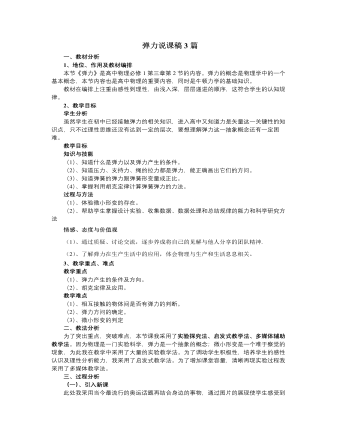
人教版新课标高中物理必修1弹力说课稿3篇
基于以上分析,为使本堂课围绕重点、突破难点,同时让学生在课堂教学中能力得到提高,我设计如下教学过程。(一)创设情景认识形变由同学们已有的形变知识入手,引入新课。教师演示:①弹簧的压缩形变;②弹簧的拉伸形变③视频播放:竹竿形变、钢丝的扭转形变。得出形变的概念及各类形变。[设计意图:我从生活情景中引入新课,是为了激发学生的好奇心,为学生学习重点和难点内容作铺垫。]设问:摩天大楼在风的吹拂下会不会摆动,发生形变吗?演示微小形变放大实验:由于这种形变不容易观察,会使学生产生疑问:到底有没有发生形变?解决的办法是微小形变的演示实验。为什么光点会往下移?让学生带着问题思考后得出结论:是由于桌面发生了形变,但是形变不明显。为后面解决压力和支持力都是弹力做好铺垫。[设计意图:使学生知道“放大”是一种科学探究的方法。]
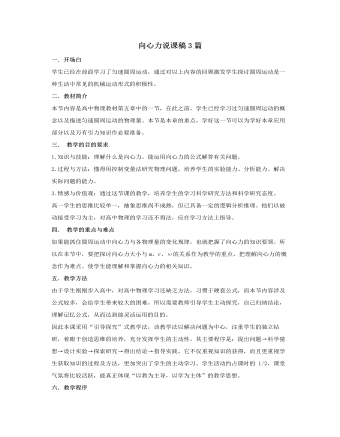
人教版新课标高中物理必修2向心力说课稿3篇
通过这个示例呢,我们可以得到解决向心力问题的一般的步骤,确定对象,找出轨迹,找出圆心,然后进行受力分析,让同学们参考这样的步骤,逐步的解决圆周运动的问题,对于变速圆周运动,我通过链球运动进行引入,这里是一个链球运动的视频,在同学们观看视频之前,我给同学们提出问题,链球收到绳子的拉力,做的是匀速圆周运动吗? 然后再课堂上我们再做一个小实验, 我们可以通过改变拉线的方式来调节小球的速度大小吗? 那么对小球,做加速圆周运动,进行受力分析,我们可以看到,小球做加速运动时,他所受到的力,并不是严格通过轨迹的圆心,在进行分析的时候,特别强调,小桶所受力的切线方向分力,和法线方向分力,切线方向分力,改变小球运动速度大小,法线方向分力,改变了小球运动的方向,法线方向的分力,在这里就是向心力,产生了向心加速度,通过这样一个例子进行分析,同学们是比较容易理解的,
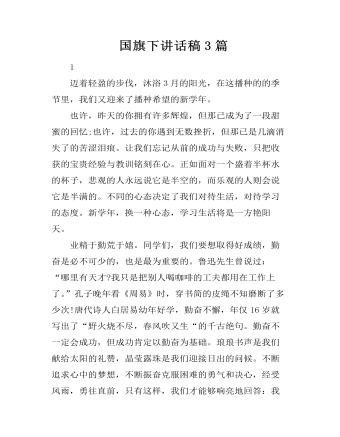
国旗下讲话稿3篇
迈着轻盈的步伐,沐浴3月的阳光,在这播种的的季节里,我们又迎来了播种希望的新学年。也许,昨天的你拥有许多辉煌,但那已成为了一段甜蜜的回忆;也许,过去的你遇到无数挫折,但那已是几滴消失了的苦涩泪痕。让我们忘记从前的成功与失败,只把收获的宝贵经验与教训铭刻在心。正如面对一个盛着半杯水的杯子,悲观的人永远说它是半空的,而乐观的人则会说它是半满的。不同的心态决定了我们对待生活,对待学习的态度。新学年,换一种心态,学习生活将是一方艳阳天。业精于勤荒于嬉。同学们,我们要想取得好成绩,勤奋是必不可少的,也是最为重要的。鲁迅先生曾说过:“哪里有天才?我只是把别人喝咖啡的工夫都用在工作上了。”孔子晚年看《周易》时,穿书简的皮绳不知磨断了多少次!唐代诗人白居易幼年好学,勤奋不懈,年仅16岁就写出了“野火烧不尽,春风吹又生“的千古绝句。勤奋不一定会成功,但成功肯定以勤奋为基础。琅琅书声是我们献给太阳的礼赞,晶莹露珠是我们迎接日出的问候。不断追求心中的梦想,不断振奋克服困难的勇气和决心,经受风雨,勇往直前,只有这样,我们才能够响亮地回答:我们没有虚度时光。
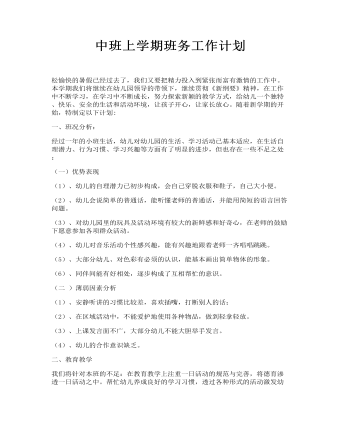
中班上学期班务工作计划
(一)优势表现(1)、幼儿的自理潜力已初步构成,会自己穿脱衣服和鞋子,自己大小便。(2)、幼儿会说简单的普通话,能听懂老师的普通话,并能用简短的语言回答问题。(3)、对幼儿园里的玩具及活动环境有较大的新鲜感和好奇心,在老师的鼓励下愿意参加各项群众活动。
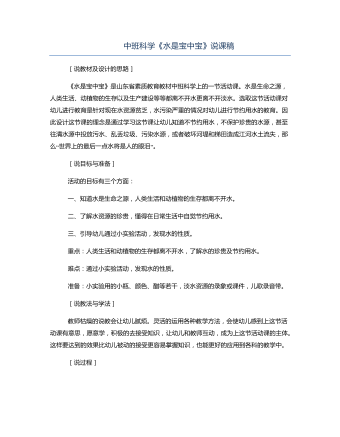
中班科学《水是宝中宝》说课稿
实验时,幼儿是主体,教师主导。运用了观察法、引导法、亲身体验法、互相交流等方式方法去完成这四个实验。例如:作实验一时,教师提壶把水到入脸盆中,让幼儿观察水的流动;当盆中盛满水后继续到水,盆中的水会是什么样的?观察后让幼儿提出自己的见解,幼儿的主动性得到发挥。例如:做实验四:让幼儿亲自闻一闻水和醋,判断水是没有气味的。幼儿通过亲身体验更能掌握知识。这四个实验的过程针对幼儿的年龄特点做的设计。学习时,幼儿对水产生了浓厚的兴趣,在不自觉中完成了学习水的性质,
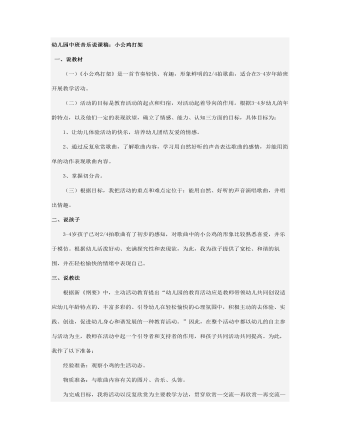
幼儿园中班音乐说课稿
第一部分:律动导入法。老师带领幼儿在音乐伴奏下,表演律动进入活动室,同时用语言、动作提示幼儿随意坐下,为活动开展创设了宽松自由的环境,把孩子引入音乐的氛围环境中。 第二部分:感知法。反复欣赏歌曲,了解歌曲的节拍、旋律特点和风格,进而理解记忆歌曲内容。在这一环节中根据幼儿年龄小、注意力难以集中等特点,运用多种欣赏手段和方法,如:听音乐、师弹音乐、师清唱歌曲、看录象等,并加以多媒体多种辅助教学手段,引导幼儿欣赏,使幼儿在积极主动的姿态中参与活动。 第三部分:表现法。采用集体、小组、个别等教学方法,鼓励幼儿大胆学唱、演唱歌曲,注意难点部分,同时在这一环节中鼓励幼儿尝试用动作表现歌曲,既增加了情趣,又能使幼儿顺利迁移已有经验,这会使幼儿感受到活动给他们带来的成功感缓和满足感。我在整个教育活动中,注意孩子活动过程和参与表演活动的情感。
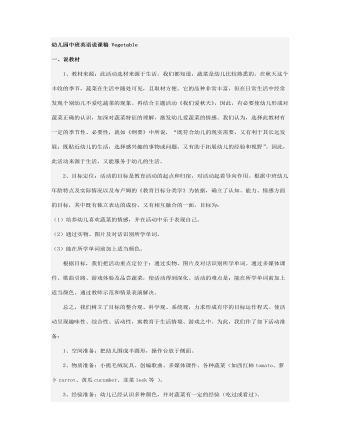
幼儿园中班英语说课稿 Vegetable
教材来源:此活动选材来源于生活。我们都知道,蔬菜是幼儿比较熟悉的。在秋天这个丰收的季节,蔬菜在生活中随处可见,且取材方便。它的品种非常丰富,但在日常生活中经常发现个别幼儿不爱吃蔬菜的现象。再结合主题活动《我们爱秋天》,因此,有必要使幼儿形成对蔬菜正确的认识,加深对蔬菜特征的理解,激发幼儿爱蔬菜的情感。我们认为,选择此教材有一定的季节性、必要性,就如《纲要》中所说,“既符合幼儿的现实需要,又有利于其长远发展;既贴近幼儿的生活,选择感兴趣的事物或问题,又有助于拓展幼儿的经验和视野”。因此,此活动来源于生活,又能服务于幼儿的生活。
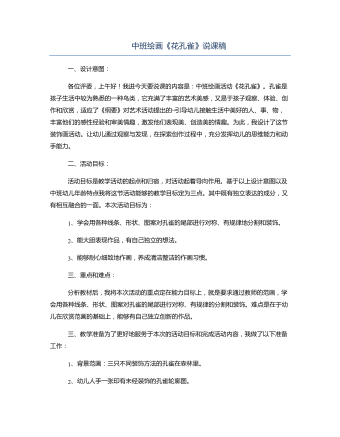
中班绘画《花孔雀》说课稿
各位评委,上午好!我进今天要说课的内容是:中班绘画活动《花孔雀》。孔雀是孩子生活中较为熟悉的一种鸟类,它充满了丰富的艺术美感,又易于孩子观察、体验、创作和欣赏,适应了《纲要》对艺术活动提出的“引导幼儿接触生活中美好的人、事、物,丰富他们的感性经验和审美情趣,激发他们表现美、创造美的情趣。为此,我设计了这节装饰画活动。让幼儿通过观察与发现,在探索创作过程中,充分发挥幼儿的思维能力和动手能力。
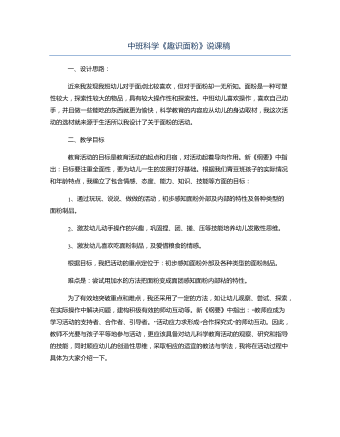
中班科学《趣识面粉》说课稿
教育活动的目标是教育活动的起点和归宿,对活动起着导向作用。新《纲要》中指出:目标要注重全面性,要为幼儿一生的发展打好基础。根据我们青豆班孩子的实际情况和年龄特点,我确立了包含情感、态度、能力、知识、技能等方面的目标:1、通过玩玩、说说、做做的活动,初步感知面粉外部及内部的特性及各种类型的面粉制品。2、激发幼儿动手操作的兴趣,巩固捏、团、搓、压等技能培养幼儿发散性思维。3、激发幼儿喜欢吃面粉制品,及爱惜粮食的情感。根据目标,我把活动的重点定位于:初步感知面粉外部及各种类型的面粉制品。难点是:尝试用加水的方法把面粉变成面团感知面粉内部粘的特性。
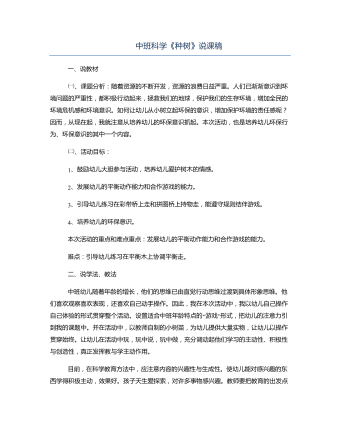
中班科学《种树》说课稿
中班幼儿随着年龄的增长,他们的思维已由直觉行动思维过渡到具体形象思维。他们喜欢观察喜欢表现,还喜欢自己动手操作。因此,我在本次活动中,我以幼儿自己操作自己体验的形式贯穿整个活动。设置适合中班年龄特点的“游戏”形式,把幼儿的注意力引到我的课题中。并在活动中,以教师自制的小树苗,为幼儿提供大量实物,让幼儿以操作贯穿始终。让幼儿在活动中玩,玩中说,玩中做,充分调动起他们学习的主动性、积极性与创造性,真正发挥教与学主动作用。目前,在科学教育方法中,应注意内容的兴趣性与生成性。使幼儿能对感兴趣的东西学得积极主动,效果好。孩子天生爱探索,对许多事物感兴趣。教师要把教育的出发点从教材转向幼儿,利用幼儿感兴趣的事物扩展成幼儿教学教育的内容,生成教育活动。因此,我在活动中,为幼儿准备了大量的废旧物,让幼儿在游戏和延伸活动中,通过自身的操作活动,达到玩中学,玩中做的目的。从而真正发挥了孩子的主体地位和教师的主导作用。在操作活动中,我还注意让幼儿在动手、动口的操作活动中达到活动的目标。
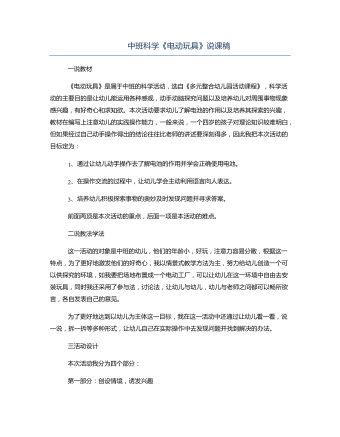
中班科学《电动玩具》说课稿
《电动玩具》是属于中班的科学活动,选自《多元整合幼儿园活动课程》,科学活动的主要目的是让幼儿能运用各种感观,动手动脑探究问题以及培养幼儿对周围事物现象感兴趣,有好奇心和求知欲。本次活动要求幼儿了解电池的作用以及培养其探索的兴趣,教材在编写上注意幼儿的实践操作能力,一般来说,一个四岁的孩子对理论知识较难明白,但如果经过自己动手操作得出的结论往往比老师的讲述要深刻得多,因此我把本次活动的目标定为:1、通过让幼儿动手操作去了解电池的作用并学会正确使用电池。2、在操作交流的过程中,让幼儿学会主动利用语言向人表达。3、培养幼儿积极探索事物的奥妙及时发现问题并寻求答案。前面两顶是本次活动的重点,后面一项是本活动的难点。
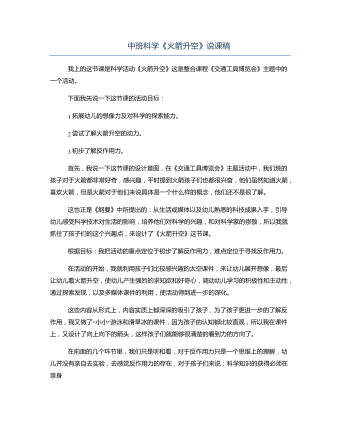
中班科学《火箭升空》说课稿
1拓展幼儿的想像力及对科学的探索能力。2尝试了解火箭升空的动力。3初步了解反作用力。首先,我说一下这节课的设计意图,在《交通工具博览会》主题活动中,我们班的孩子对于火箭都非常好奇,感兴趣,平时提到火箭孩子们也都很兴奋,他们虽然知道火箭,喜欢火箭,但是火箭对于他们来说具体是一个什么样的概念,他们还不是很了解。这也正是《纲要》中所提出的:从生活或媒体以及幼儿熟悉的科技成果入手,引导幼儿感受科学技术对生活的影响,培养他们对科学的兴趣,和对科学家的崇敬,所以我就抓住了孩子们的这个兴趣点,来设计了《火箭升空》这节课。